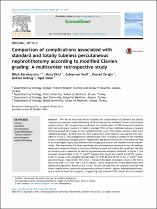| dc.contributor.author | Karakoyunlu, Ahmet Nihat | |
| dc.contributor.author | Ekici, Musa | |
| dc.contributor.author | Yeşil, Süleyman | |
| dc.contributor.author | Zengin, Kürşad | |
| dc.contributor.author | Göktuğ, Göksel | |
| dc.contributor.author | Özok, Hakkı Uğur | |
| dc.date.accessioned | 2019-05-13T09:08:44Z | |
| dc.date.available | 2019-05-13T09:08:44Z | |
| dc.date.issued | 2014 | |
| dc.identifier.citation | Karakoyunlu, N., Ekici, M., Yeşil, S., Zengin, K., Göktuğ. G., Özok, U. (2014). Comparison of complications associated with standard and totally tubeless percutaneous nephrolithotomy according to modified Clavien grading: A multicenter retrospective study. The Kaohsiung Journal of Medical Sciences, 30(12), 613-618. | en_US |
| dc.identifier.issn | 1607-551X | |
| dc.identifier.uri | https://doi.org/10.1016/j.kjms.2014.09.006 | |
| dc.identifier.uri | https://hdl.handle.net/11491/2045 | |
| dc.description.abstract | The aim of this study was to compare the complications of standard and totally tubeless percutaneous nephrolithotomy (PCNL) based on the modified Clavien complication grading system. We retrospectively evaluated the complications of 290 consecutive patients who had undergone standard or totally tubeless PCNL at four institutes between January 2010 and August 2012 based on the modified Clavien scale. The totally tubeless cases were classified as Group 1 and the cases to which a Malecot re-entry catheter was applied were classified as Group 2. The postoperative complications were recorded according to the modified Clavien complication grading system. Statistically significant differences were observed only in the first-degree injury class between the two groups based on the modified Clavien classification. The requirement for blood transfusion and prolonged percutaneous access site leakage were more frequent in Group 2, but these differences were not statistically significant. We also performed a pain evaluation by monitoring postoperative analgesia demands. In Group 1, the analgesic demand rates in the 1st and 6th postoperative hours were 64.6% and 31.5%, respectively. In Group 2, the analgesic demand rates were 87.5% and 58.75% in the 1st and 6th postoperative hours, respectively. The mean ± standard deviation of analgesic doses in the first 6 hours was 0.96 ± 0.7 and 1.46 ± 0.6 in Groups 1 and 2, respectively. These differences were statistically significant. Based on our results, we can conclude that the tubeless technique has fewer complications, improved postoperative patient comfort, shorter hospitalization times, and a reduced need for analgesics, suggesting that tubeless PCNL should be the standard approach. For suitable cases, this technique may be used safely as the standard PCNL approach. Copyright © 2014, Kaohsiung Medical University. Published by Elsevier Taiwan LLC. All rights reserved. | en_US |
| dc.language.iso | eng | |
| dc.publisher | Elsevier Taiwan LLC. | en_US |
| dc.relation.isversionof | 10.1016/j.kjms.2014.09.006 | en_US |
| dc.rights | info:eu-repo/semantics/openAccess | en_US |
| dc.subject | Clavien | en_US |
| dc.subject | Standard Percutaneous Nephrolithotomy | en_US |
| dc.subject | Totally Tubeless Percutaneous Nephrolithotomy | en_US |
| dc.title | Comparison of complications associated with standard and totally tubeless percutaneous nephrolithotomy according to modified Clavien grading: A multicenter retrospective study | en_US |
| dc.type | article | en_US |
| dc.relation.journal | Kaohsiung Journal of Medical Sciences | en_US |
| dc.department | Hitit Üniversitesi, Tıp Fakültesi, Cerrahi Tıp Bilimleri Bölümü | en_US |
| dc.authorid | 0000-0002-9155-4126 | en_US |
| dc.identifier.volume | 30 | en_US |
| dc.identifier.issue | 12 | en_US |
| dc.identifier.startpage | 613 | en_US |
| dc.identifier.endpage | 618 | en_US |
| dc.relation.publicationcategory | Makale - Uluslararası Hakemli Dergi - Kurum Öğretim Elemanı | en_US |


















